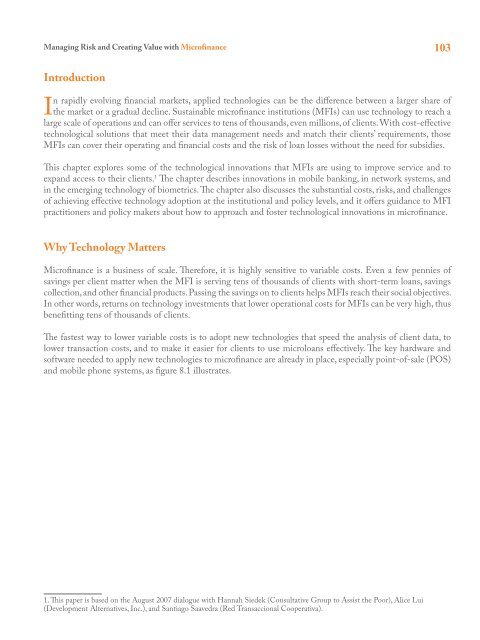managing risk.pdf
managing risk.pdf
managing risk.pdf
Create successful ePaper yourself
Turn your PDF publications into a flip-book with our unique Google optimized e-Paper software.
Managing Risk and Creating Value with Microfinance103IntroductionIn rapidly evolving financial markets, applied technologies can be the difference between a larger share ofthe market or a gradual decline. Sustainable microfinance institutions (MFIs) can use technology to reach alarge scale of operations and can offer services to tens of thousands, even millions, of clients. With cost-effectivetechnological solutions that meet their data management needs and match their clients’ requirements, thoseMFIs can cover their operating and financial costs and the <strong>risk</strong> of loan losses without the need for subsidies.This chapter explores some of the technological innovations that MFIs are using to improve service and toexpand access to their clients. 1 The chapter describes innovations in mobile banking, in network systems, andin the emerging technology of biometrics. The chapter also discusses the substantial costs, <strong>risk</strong>s, and challengesof achieving effective technology adoption at the institutional and policy levels, and it offers guidance to MFIpractitioners and policy makers about how to approach and foster technological innovations in microfinance.Why Technology MattersMicrofinance is a business of scale. Therefore, it is highly sensitive to variable costs. Even a few pennies ofsavings per client matter when the MFI is serving tens of thousands of clients with short-term loans, savingscollection, and other financial products. Passing the savings on to clients helps MFIs reach their social objectives.In other words, returns on technology investments that lower operational costs for MFIs can be very high, thusbenefitting tens of thousands of clients.The fastest way to lower variable costs is to adopt new technologies that speed the analysis of client data, tolower transaction costs, and to make it easier for clients to use microloans effectively. The key hardware andsoftware needed to apply new technologies to microfinance are already in place, especially point-of-sale (POS)and mobile phone systems, as figure 8.1 illustrates.1. This paper is based on the August 2007 dialogue with Hannah Siedek (Consultative Group to Assist the Poor), Alice Lui(Development Alternatives, Inc.), and Santiago Saavedra (Red Transaccional Cooperativa).
















